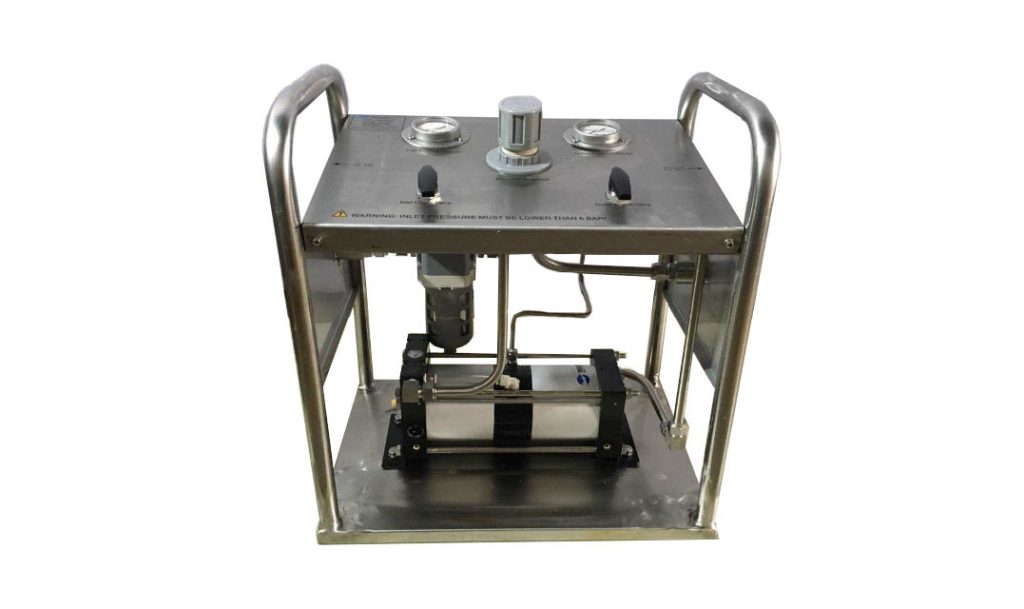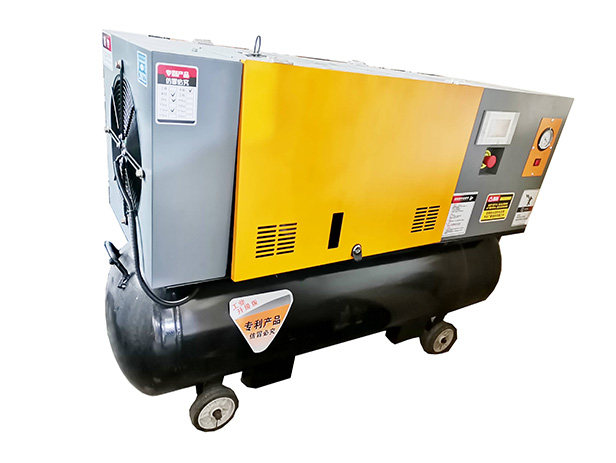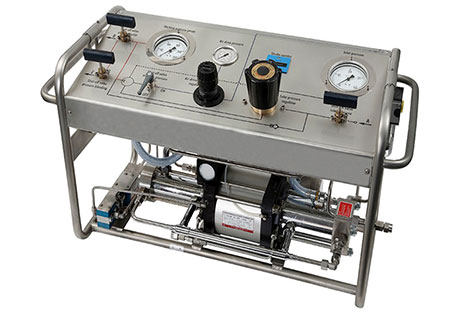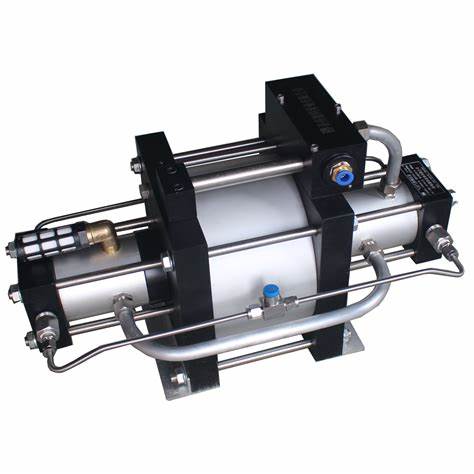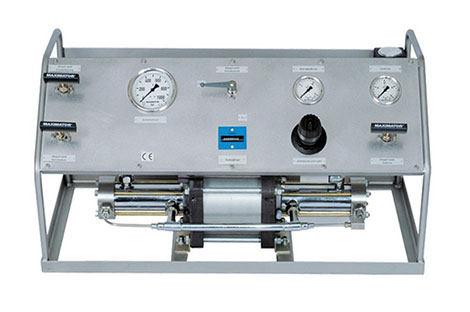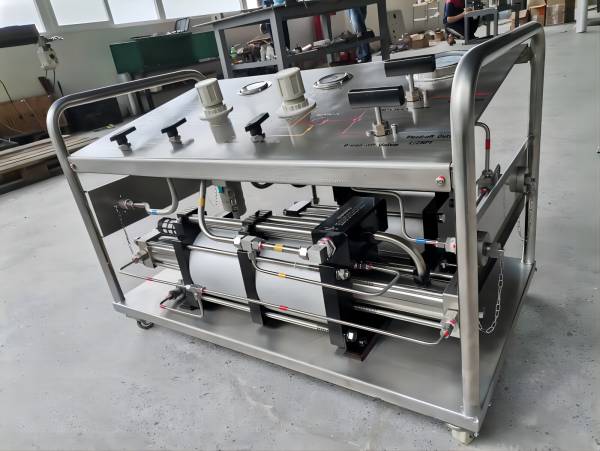Cleaning Industrial Pipes: Methods, Tools, and Safety Tips
Pipelines play an essential role in the petrochemical industry for transporting crude oil, natural gas, and chemical solutions. Any build-up of deposits, corrosion products, or chemical residues on inner pipe walls may reduce fluid transportation efficiency and even create serious safety concerns such as leakage, corrosion and explosion with long-term service.
As such, cleaning industrial pipeline has become an essential practice to ensure operational effectiveness, safety compliance and extended system lifespan. This is especially required in a high-risk media environment, where safety during cleaning process is of paramount importance, and the nitrogen booster unit takes center stage in such an application.
Part 1. Common Types of Contaminants in Industrial Pipelines
In petrochemical enterprises, industrial pipelines are exposed to a vast range of fluid media for extended periods and therefore are highly susceptible to all types of contamination.
These contaminants not only reduce transmission efficiency but also lead to equipment destruction, production losses, and even lethal safety accidents. What follows are some of the most common types of contaminants in petrochemical pipeline systems:
1. Rust and Oxides
Pipes that transport water-containing or acid media (such as H2S or CO2) for extended periods can experience electrochemical corrosion that leads to the deposition of rust and oxide deposits on their inner pipe walls, often flaking off and collecting in low flow areas like bends, joints or bends, creating flow blockages or weakening its integrity and predisposing to leakage or ruptures.
This damage also weakens structural integrity weakening it potentially leading to leaks or ruptures weakened structural integrity leaving leaks or ruptures exposed.
2. Deposits of Grease and Sediment
Grease and oil deposits are common in pipelines carrying crude oil, lubricants or other hydrocarbon fluids; their viscous nature attracts other particles such as sand, silt or metal filings to form thick sediment layers over time that restrict effective flow area while also polluting measurement and control systems.
Not only do such accumulations diminish effective flow rate but they can contaminate fluid measurement systems as well.
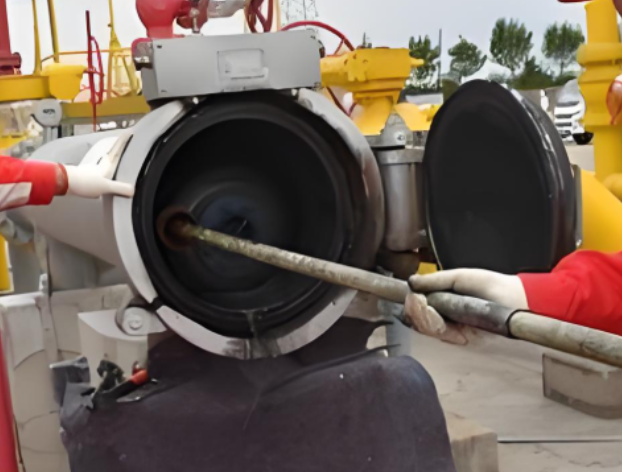
3. Microbial Growth and Biofilm Formation
Microorganisms such as bacteria, fungi and algae often proliferate in warm and moist environments such as water-carrying pipes in warm climates; their profusion allows biofilms to form that not only contribute to under-deposit corrosion but can also compromise product purity. Some microbial byproducts are highly corrosive, which further augments equipment degradation.
4. Chemical Scale and Residues
In chemical processing, reaction product deposits, cleaning agent, or solvent deposits can be left behind in pipelines unless these are properly flushed or dried out during shutdown.
These can crystallize or precipitate at high temperature and pressure to form hard chemical scale or crystalline deposits. These are generally difficult to remove by ordinary means and can severely compromise flow and heat transfer performance.
These impurities are of diverse nature and often complex in origin and therefore difficult to eliminate. But if not eliminated on time, they can lead to loss in product quality, energy consumption, and premature shutdown of equipment. So, a well-planned cleaning schedule, is the answer to the problem of ensuring safe and efficient operation of petrochemical pipeline systems.
Part 2. How to Clean Pipeline in the Petrochemical Industry
Within the petrochemical industry, pipeline cleaning is a significant maintenance activity that ensures operational safety, product integrity, and equipment longevity. Depending on the type of contaminant, pipeline material, and onsite conditions, the most commonly used techniques are as follows:
Method 1. Mechanical Cleaning
Mechanical cleaning makes use of physical devices to physically scrape the deposits from the inner walls of pipes. It is optimally used for straight sections of pipelines with no complex branching. A few of the tools that are commonly used include:
- Scrapers: Most effectively used to scrape away thick deposits such as wax or coke.
- Steel Brushes: Used for removing rust layers or hard scale.
- Pipeline Pigs: Introduced into the pipeline and propelled by gas or fluid pressure, these devices scrape and push impurities out of the pipe.
Mechanical cleaning is simple and cheap but may have a hard time reaching all areas in bent or branched pipelines, creating cleaning blind spots. It’s also less effective at removing oil-based residue.
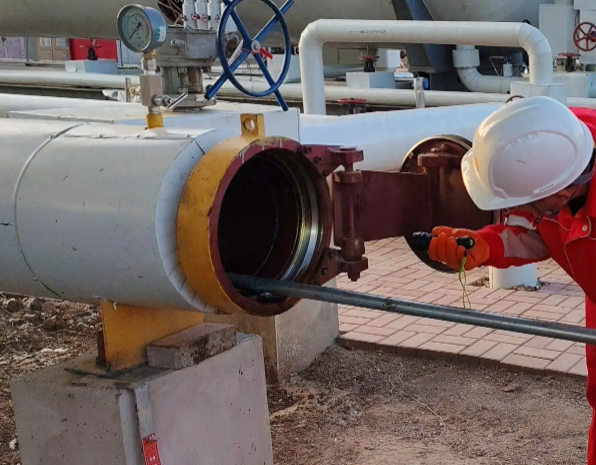
Method 2. Chemical Cleaning
Chemical cleaning utilizes acids, alkalis, or solvents to dissolve, emulsify, or strip off chemically the impurities. It is especially effective at removing:
- Acid Cleaning: Removes rust, carbonate scale, and oxides.
- Alkaline Cleaning: Attacks organic material such as grease or carbon deposits.
- Solvent Cleaning: Used for dissolving organic films and high-viscosity oil residues.
This method gives penetration and cleaning in depth, even for complex systems. Chemical cleaning, nevertheless, must be well controlled in terms of concentration, temperature, and reaction time to avoid the generation of toxic gases or equipment damage. Ventilation and personal protection must be ensured during the process.
Method 3. High-Pressure Water Jet Cleaning
High-pressure water jetting is an environmentally friendly, chemical-free cleaning method used to remove stubborn contaminations. Its principal features are:
- Water is compressed to 50–200 MPa by a specialized pump to create high-energy jets;
- Efficiently removes rust, scale, grease, and coke deposits;
- No chemicals are required, so it is environmentally friendly and safe;
- May be applied to straight pipelines, heat exchangers, towers, and storage tanks.
Though highly effective, this process must be well-controlled not to cause pipeline material damage due to the high pressure.
Method 4. Nitrogen Purging & Drying
Nitrogen purging is the act of using inert nitrogen gas to displace air or hazardous gases from tanks or pipelines. It plays a significant role before and after the cleaning activity:
- Pre-cleaning: Displaces flammable, explosive, or toxic gases to create a safe state for chemical cleaning or high-pressure activities;
- Post-cleaning: Dries water residue or cleaning agents rapidly to prevent corrosion or cross-contamination;
Oxygen concentration measurement may be included to ensure purging for safety standards.
To meet the high-volume and high-pressure nitrogen requirements for purging, a nitrogen booster unit is typically used. It raises low-pressure nitrogen to the desired pressure, allowing total gas displacement and efficient drying.
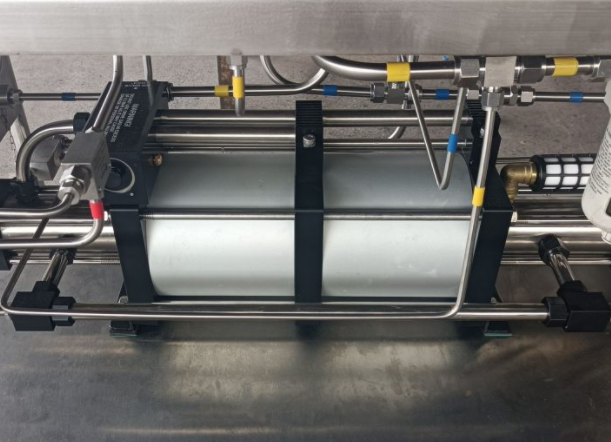
Petrochemical pipeline cleaning typically requires a composite approach based on the particular pipeline system, degree of contamination, and fluid properties. Nitrogen purging and drying is one such auxiliary process that, when paired with a nitrogen booster unit, can significantly enhance the safety, efficiency, and reliability of the entire cleaning operation.
Part 3. Benefits of Using Nitrogen Booster Unit
A nitrogen booster unit is an essential equipment to enhance the safety and efficiency of pipeline purging and drying operations in the petrochemical industry. Some of the key benefits that make this equipment vital for industrial use are given below.
Adaptable to Various Operating Conditions
The nitrogen booster unit was specifically created to meet the demands of various pipeline sizes, from single diameter diameter and length pipes through complex multi-branch and fitting configurations with multiple fittings and branches. This makes it ideally suited for various petrochemical systems as it ensures reliable nitrogen purging and drying regardless of pipeline size or complexity.
High Safety Performance
Nitrogen is an inert gas that will not support combustion. By purging the pipelines with nitrogen, we effectively eliminate any risks of explosion and fire caused by oxygen or other flammable gases in their presence.
With nitrogen booster unit providing continuous high purity nitrogen supplies to maintain an unreactive, safe environment for cleaning and maintenance operations, nitrogen purging effectively protects against explosion and fire risk.
Engineered for maximum performance, the nitrogen booster unit’s design allows it to quickly supply high flow rates and pressures – speeding up drying and purging processes significantly. High pressure nitrogen quickly displaces moisture and harmful gases, cutting down on downtime and total project turnaround time while its high output pressure ensures good cleaning in complex or long pipeline sections.
Ease of On-site Operation
A nitrogen booster unit is typically a skid-mounted mobile unit designed for easy installation at various points throughout large petrochemical plants. Due to this mobility, it makes an excellent solution for maintenance and turnaround services where flexibility and minimal setup time are essential. Furthermore, its easy-to-use controls and durable design facilitate safe field operation under severe industrial conditions.
Part 4. Wingoil Nitrogen Booster Unit: Your Reliable Choice for Industrial Pipeline Operations
In industrial pipeline cleaning and maintenance operations, the efficiency and safety of gas booster equipment have a direct impact on the efficiency and safety of pipeline operations. Wingoil nitrogen booster unit is specially designed to meet different pressure and flow requirements, being an ideal choice for high-pressure nitrogen supply for oil, petrochemical, and other industrial uses.
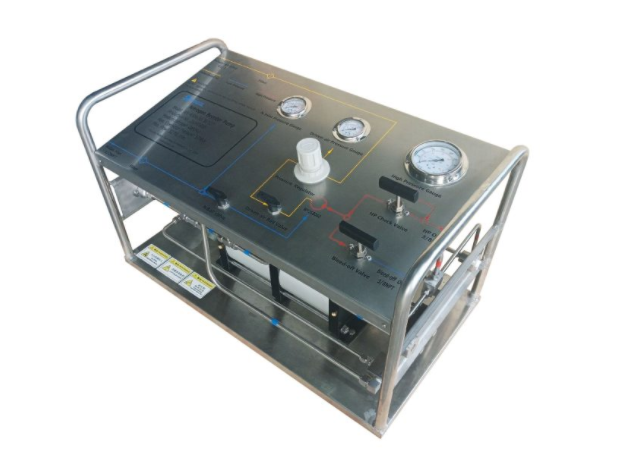
Wingoil nitrogen booster unit is a custom gas-driven booster unit suitable for high-pressure air and nitrogen supply. The space-saving slide-rail design allows easy and space-efficient installation. High-pressure components are made of stainless steel for increased durability and safety in harsh industrial environments.
The primary components include a booster pump, pressure regulator, air filter, pressure gauges, nitrogen ball valves, high-pressure check valves, and respective gas piping interfaces, all of which ensure stable and reliable system operation.
Key Features
High Pressure and Large Flow Capacity: Maintains a maximum operating pressure of up to 539 bar (8000 psi) and a maximum flow rate of 327 NL/min, meeting various industrial pipeline demands.
Precise Pressure Control: Equipped with dual-scale dampened pressure gauges and pressure lock function to supply stable outlet pressure without sudden change.
User-Friendly and Safe Operation: Designed with a central control panel for easy monitoring and operation with flexible drive air pressure adjustment.
No Electricity Required, High Environmental Adaptability: No electrical power operation makes it adaptable to non-electrified or explosion-proof environments.
Quick-Connect Interfaces: Standard NPT interfaces with quick-release connectors for easy on-site installation and dismantling.
Application Benefits
Safe and Reliable: Nitrogen is an inert gas that reliably prevents pipeline explosions and fire hazards.
Improved Operational Efficiency: High flow and high pressure design provide quick purging and displacement, raising the efficiency of pipeline cleaning and testing.
Suitable for Various Environments: Anti-corrosive material and non-electric design guarantee adaptability to severe petrochemical environments.
Flexible Configuration: Can be designed to specific pressure and flow requirements, meeting diverse needs across a broad variety of industries.
For purging, drying, or pressure testing of pipeline, Wingoil nitrogen booster unit WY-400N/30-J0 is your perfect partner for industrial pipeline maintenance and cleaning. With its outstanding performance and consistent quality, it helps to ensure your pipeline systems’ efficient and safe operation.
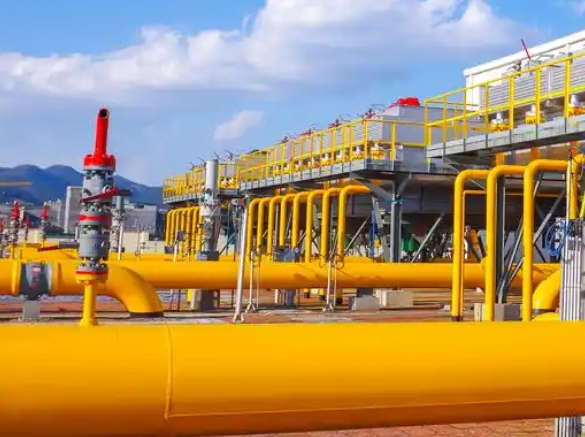
Final Thoughts
Industrial pipe cleaning is not a cleaning task but a significant part of system safety as a whole. Especially in the petrochemical industry, where operating conditions are harsh and media are complex, even a tiny residue or leak can lead to catastrophic consequences.
As an important auxiliary device in modern industrial cleaning, the nitrogen booster unit significantly improves the cleaning efficiency while ensuring the safety of the cleaning process. It is not just equipment, it is an indispensable factor in establishing a safe and reliable cleaning workflow.

